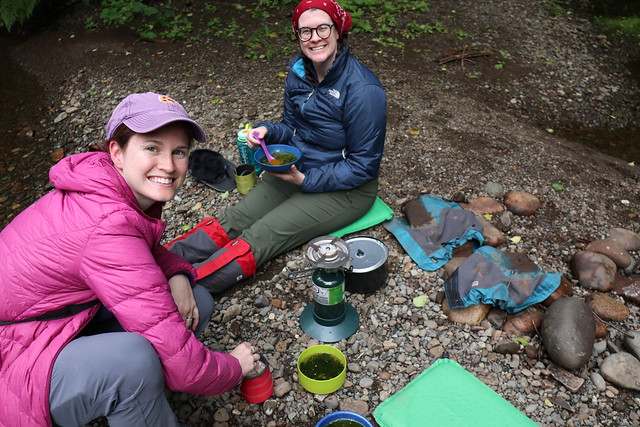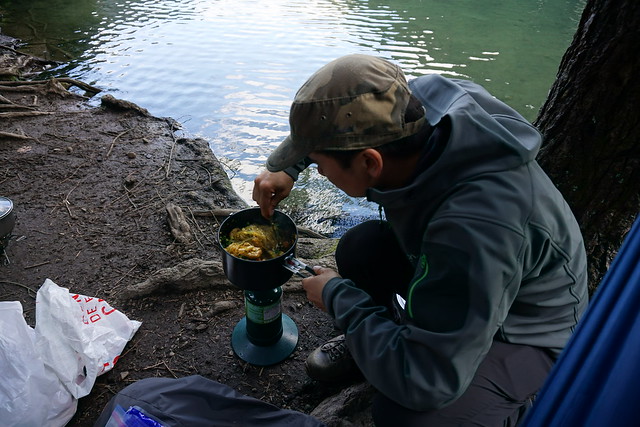Continuing the trend from my cold soak post, I want to share some of my favourite hot meals for dinner! I’ve decided to do a 2-part post, focusing first on hot meals I make with my dehydrator, and second on simple meals that you can easily pull together with grocery store ingredients (no dehydration required). I’d say that the at-home dehydrated meals are tastier, but require a lot more effort, so sometimes it’s nice to just run to the store and be good to go. Here’s a few of my favourites:
1. Curry and Rice
Curry and rice is really a staple backpacking food for me. It can be kind of tricky to get right though because a lot of curries are oily or have chicken in them, neither of which dehydrate well. Since Emily is vegan and Carolyn avoids dairy, I found that a vegetarian coconut curry is a great compromise on all fronts. There are lots of recipes for vegetable curries that use coconut milk for the base and chickpeas for protein. I like to use butternut squash, yam, and carrot in mine because the squash boils down into a thick sauce and it dehydrates really well. My recipe is an adaptation of these two recipes from Trail Recipes and Fresh off the Grid. Once I’m finished making the curry, I dehydrate it for 8 hours and then add rice when I cook it at camp.
Another option is to just buy a curry from your local Indian restaurant and pop it in the dehydrator, but like I said, it can be hard to avoid oils this way. I was successful once by mixing a vegetable curry with the rice (to absorb some of the oil) and then putting the whole thing in the dehydrator. But I still had to let it sit on paper towel for a day to absorb the residual oil and I stored it in the freezer until my trip.
2. Macaroni and Chili
In my opinion, this is as easy as it gets when it comes to dehydrating. You can make your own chili from scratch and then pop it in the dehydrator for 8 hours, but 90% of the time I just run by the grocery store and pick up my favourite canned chili and pop it straight in the dehydrator. Most chili is made with ground beef or beans, so it dehydrates really well. Once at camp, I rehydrate and heat with dry macaroni noodles until the whole thing is cooked.
3. Stew/Soup of your choice
What’s your favourite soup to eat at home? Mine are minestrone and peanut stew, so whenever I make one, I always set aside a serving or two to run through the dehydrator. I’m all about turning my day to day meals into backpacking meals rather than looking for new recipes. If you don’t have a dehydrator, you can check out my next post about easy grocery store meals, otherwise my recommendation is to focus on dehydrating meals as a whole rather than piecemeal. I think a lot of people focus on dehydrating each component separately and then putting it all together, but I’ve found that to be a lot more work. If you don’t have go-to soup recipe, try picking up your favourite canned soup from the store and see how it dehydrates.
4. Pasta of your choice
I’m sorry if you came to this post looking for actual recipes, but I’m not a chef and there are tons of resources out there already, so this is meant to be more about meal ideas than concrete recipes (although it probably tells you a lot about the slapdash way that I usually cook). I’m always adapting recipes to make them vegan or vegetarian, so I see them more as a guideline anyways. But if you don’t know where to start, check out Fresh off the Grid, which is one of my favourite resources for backcountry cooking. Like with the soup, pick your favourite pasta recipe and pop it in the dehydrator. For me, it’s a penne bolognese that has a tomato and soymeat base, with lots of veggies added to it. But there are other options out there, like pasta primavera, penne alfredo, or even a peanut butter based pasta like I shared in my cold soak post. The key is to use smaller pasta noodles that dehydrate easier, although I’ve never actually tried dehydrating a spaghetti and I’m sure it is possible.
5. Mexican or Fried Rice
This is another recipe that I shared in my cold soak post, but which works great for a hot supper. For Mexican Rice, I fry up onion and pepper with salsa and taco seasoning and then add tomato, corn, carrot, black beans and sometimes spinach. For my fried rice, I rely more on vegetable stock and traditional spices for the flavour. I usually add lentils for protein and I might throw some powdered egg into the final dry mix. But if you have another favourite rice dish, give it a try in the dehydrator! Dehydrating is all about experimenting!


Great